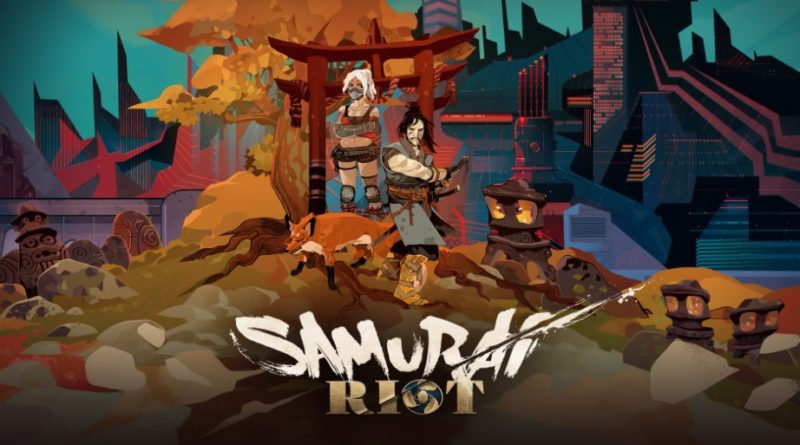Samurai Riot: Definitive Edition Review (Switch) – Streets of Dishonour
A Samurai-inspired Beat ‘Em Up with a focus on story, is Samurai Riot the riotous fun it hopes to be? The Finger Guns Review.
Having only played Streets of Rage for the first time about a year ago and for a max of about an hour, it’s fair to say it’s something of a mystery to me. My fellows at Finger Guns are rather experienced Beat ‘Em Up fans from the by-gone days, but my infant self has next to no experience of them outside of an occasional excursion.
With that in mind, I jumped into Samurai Riot: Definitive Edition, just released on Switch with a host of promised improvements and upgrades from its original 2017 release. This new iteration aimed to provide new animations, dialogue, improved stability and optimisation and get it running at a smooth 60fps. Fair to say the 5 years following the original game have been spent trying to vastly improve the package itself for its re-emergence on a new platform.
So, does this new re-release with its host of promised upgrades bring honour upon the Samurai ways, or disgrace the name of its clan with reckless abandon?
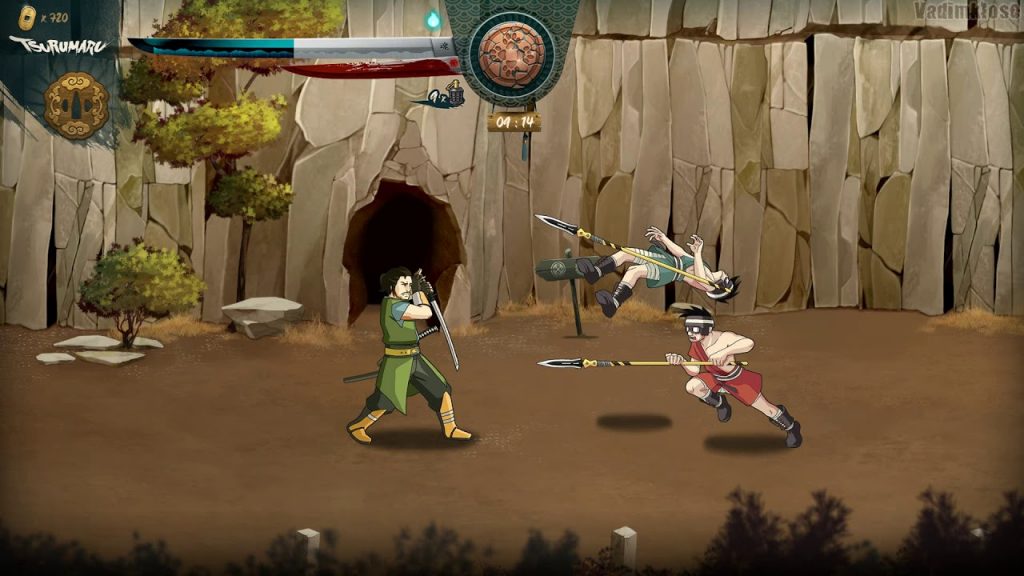
Beauty in War
Let’s start with those proposed graphical and performance promises. Samurai Riot thoroughly delivers in terms of the gloriously smooth animations, with character models gliding across the 2D surface with the grace of a vicious, violent gazelle. Attack animations, punchy recoil responses, dynamic effects all look sharp and pristine, which does a lot to sell the initial appeal of its Japanese setting. Seeing a miscreant rodent twaddle off with my reward coins or health pick up is all the more charming when it runs so smoothly.
In large part, this is thanks to the improved framerate, which to its credit holds up well throughout your campaigns as a Samurai warrior. I had a couple of moments of chugging when there were multiple spear-wielding peasants to fell at once, but on the whole it delivers on the promise of a crisp and sharp technical performance.
Levels and backdrops themselves are a bit more mixed. The backdrops are brought to life well, though do feel a little too empty or lifeless at times. There are some moments of strong art direction but these are interspersed throughout bland interior areas or dulled through repetition as missions progress. Forest and outdoor scenes far much stronger and instil a bit of wonder, but given the frenetic pace of combat you won’t be really stopping much to admire the scenery, nor do you have much incentive to.
Still, the animation continued to impress me the further I played and that’s the more core tenet of a Beat ‘Em Up.
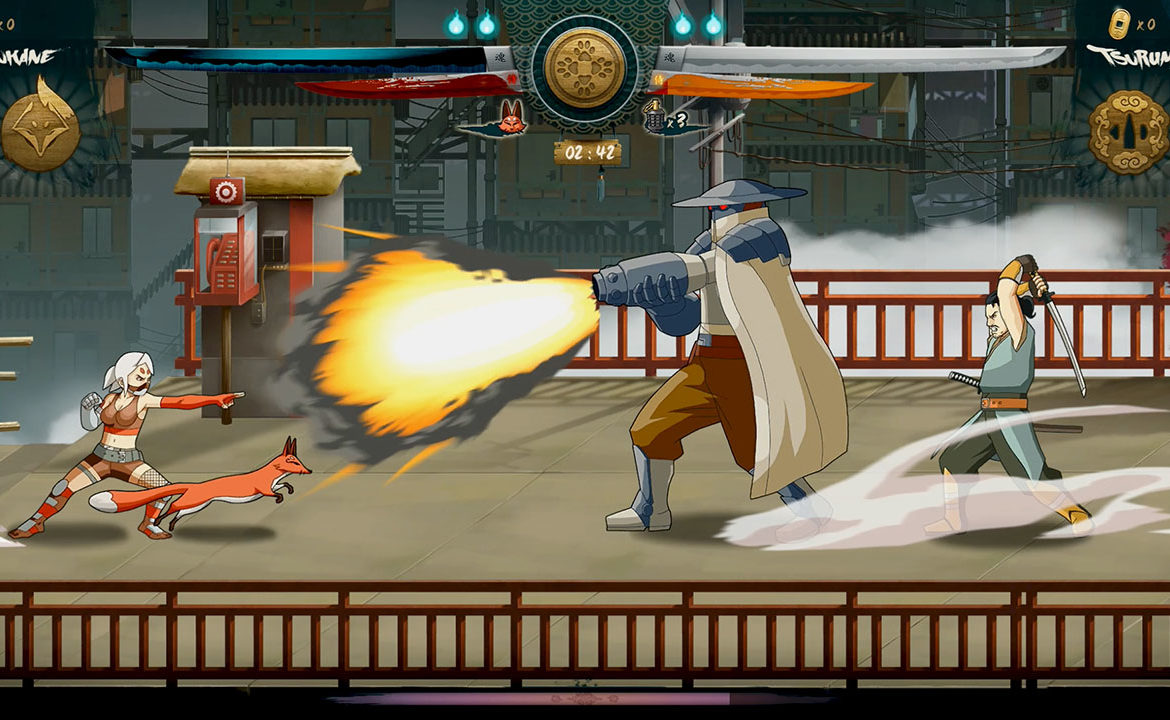
Swords, Bombs and… Foxes?
Before embarking on your journey you’ll select between two protagonists – Sukane or Tsuruamaru – each with their own fighting style and special abilites. Sukane is a hand-to-hand combat whirlwind, while Tsurumaru is a master of the blade. There’s some nuance to each character, for example Sukane dodge-flips instead of blocks attacks, or uses her trusty companion Azu (the goodest fox) to blast forward in place of Tsurumaru’s grenade throws. Both have their own close-quarters special flurry of attacks and a crowd-decimating explosive special (cannon balls instead of grenades).
You’d think this would provide an ample sense of variety and depth to the combat system but the reality is slightly more shallow than you might expect. While Sukane hits faster but weaker and she has different animations for her fighting style, the core combat system is exactly the same across both central figures. The only fundamental difference in how you play is that Tsurumaru can block attacks outright, which is a massive advantage in your runs.
For example, a late-game boss I took on with both characters was exceptionally more arduous as Sukane as you’re constantly taking hits from attacks with little wind-up animation and having to switch distances more frequently than is fun. In fact, my campaign as Sukane was mainly defined by how many more times I got stun-smashed and was always just spamming through opponents than thinking tactically. It made her a far less compelling gameplay choice as a result, even despite getting better rankings with her than Tsurumaru.
Regardless of which you select, you’ll be largely doing the same thing for each level – mashing attacks on opponents, blocking/dodging their swipes, using your 2 specials once your fury meter is filled, then running to the next encounter. Despite a typical campaign lasting only an hour, it’ll already start to feel a bit stale and repetitive come the end. Your second campaign has the benefit of playing as the alternative hero, but after the initial intrigue you’ll quickly notice falling into the same rhythm.
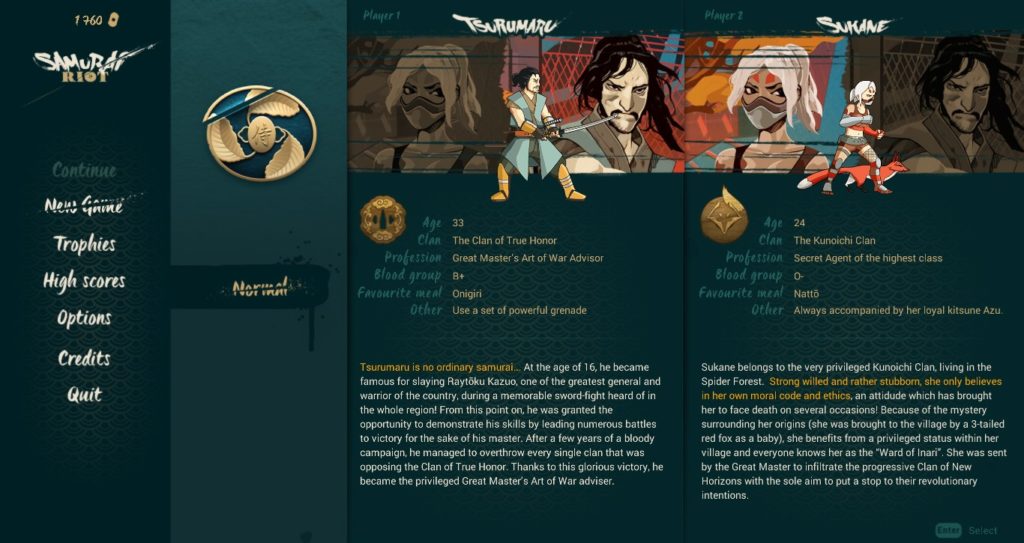
Finish Him… With Honour
Each of the 8 levels you’ll wind up chopping through with progressively throw more and more enemies at you, with new varieties and obstacles to overcome. Initial spear-men are easily picked off, while later variants charge at different distances. Big sumo dudes tank your attacks and have unblockable charge slams or shield-spinning whirls of pain. Close-quarters fighters will uppercut you with the glee of a sadistic eruption of pain. Each presents their own challenge and it’s your job to intuitively figure them out and find a strategy to get through without getting wrecked.
For the most part, you can spam your way through encounters pretty successfully. Only a couple of varieties have the means to effectively block or counter you, making it rather trivial 80% of the time. Those that can usually are able to through pretty… well, shitty means. No wind-up animations for warning, nanosecond actions that can cancel your attack mid-combo, stun-locking your avatar, that kind of thing. They come out much more frequently in the later levels which adds to the sense of repetition, as while each type has variants, they’re still fundamentally the same enemy, so you’ll rapidly develop a malaise towards the opponent types.
Rounding off each level will be a boss encounter, ranging from a giant spider to a mechanical Samurai with a canon for an arm. Some are ridiculously easy to abuse, like waiting for a specific attack to counter from, or are nonsensically frustrating to fight by how they can rip you apart through furiously fast combos you can’t do much to counter. When it gets bosses right, it can feel like a rewarding dance of death and damage-swapping. But when it gets it wrong, they can be arduous progress-blockers who take too long to take down, making the experience all the more unrewarding.
Once you’re done bashing through through a level’s adversaries though, you may just be rewarded with a moral quandary which will shape your journey’s conclusion.
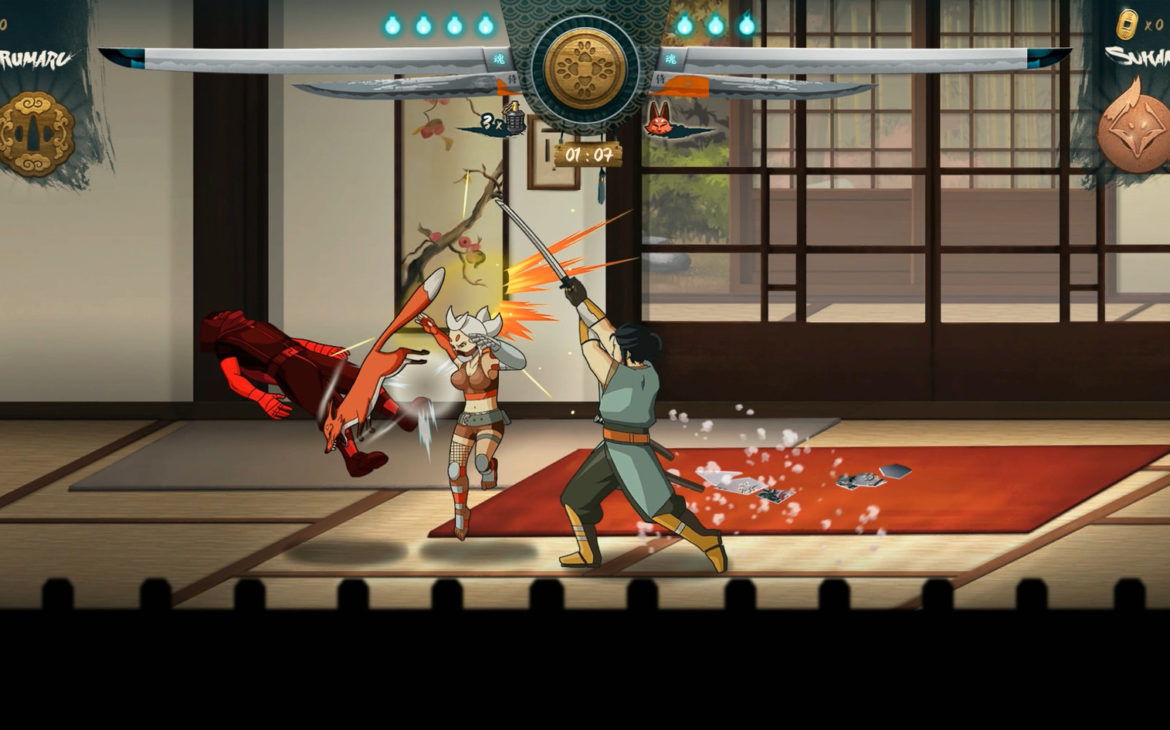
To Rebel or Not To Rebel
Boasting of 8 (EIGHT!) possible endings, Samurai Riot heralds the opportunity for player choices at particular forks in the road upon your adventure. Sukane and Tsurumaru embark on their quest seeking to quell a troublesome uprising for their grandmaster, only to be faced with the stark reality of the suffering in the world outside their respective clans. Your first choice offers up a chance to join said rebellion and forsake your honour or to uphold your master’s will and serve your clan dutifully.
Regardless of which choice you make, you’ll be faced with a further 2-3 choices, with each level diverging depending upon which path you’ve trodden. I played two campaigns through making completely opposite choices to see if it conjured up some wildly different scenarios and found that, like the gameplay, it kind of flatters to deceive. I fought the same bosses, met the same central figures and diced through largely the same locales. Some dialogue and story beats expectedly shifted, but the overall narrative barely altered. My ending was certainly different, but the means of getting to it didn’t seem to experience much of a change.
Like I said before, a campaign only lasts about an hour so theoretically, having some distinct and unique campaign sequences shouldn’t have been too big an ask, so it’s all the more disappointing how repetitive both my runs felt. I would have completed a third, but I ran into an infuriating bug where my non-controlled character would get stuck transitioning between scenes on 3 occasions. Twice in the middle of a mission, once at the very end after beating a boss. 2 of those times were on the same level. Each time it happened, I had to reboot the game, losing the mission’s progress as there’s no checkpoints. Look, a level typically takes 5-10 minutes, no biggy if it happens once, but if you’re not going to have mid-game saves, it needs to be flawless performance-wise, and this certainly wasn’t.
The third time at the end of the level tipped my annoyance over the edge. Coupled with the repetitive gameplay and lack of story paths generating any substantial interest, I decided to call it a day. 2 and a half hours already felt like a bit too much, with the prospect of another 5-6 hours and more lost progress to this agonising glitch too much for me to be willing to play any further.
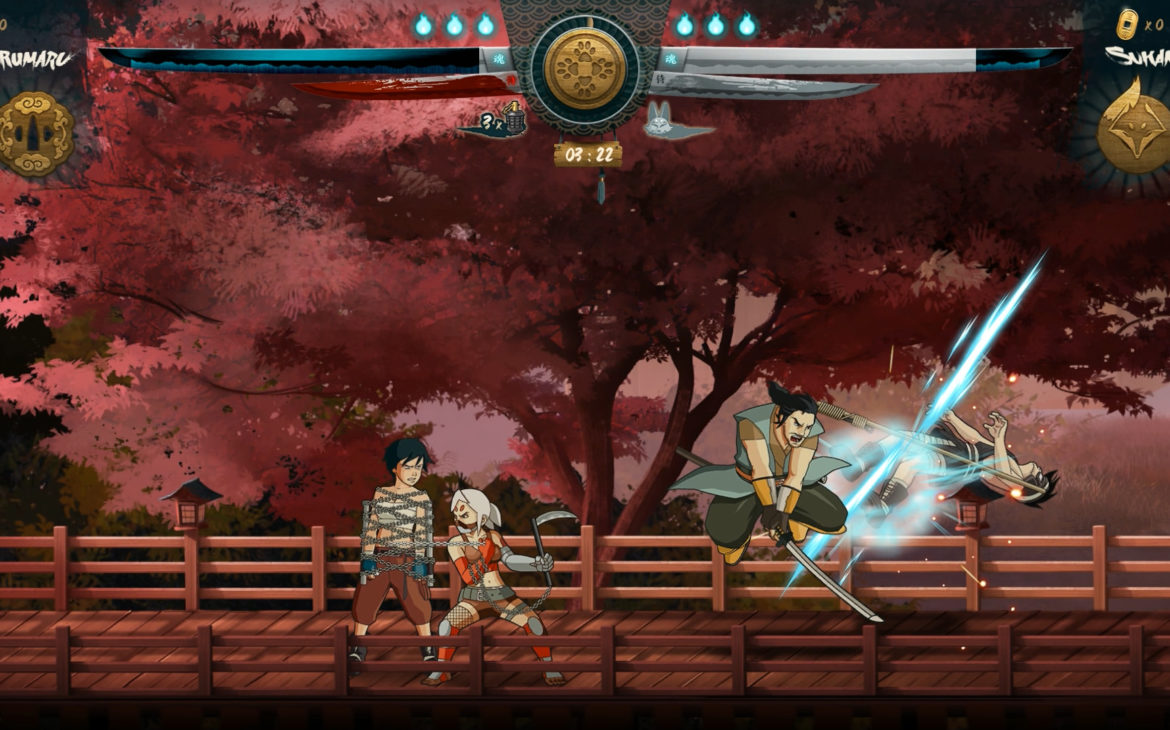
Slay The Oni and Peasants, Together
Naturally, given there’s 2 playable heroes (or villains, depending on your choices, you monster), you can punch and swing your way through the entirety of Samurai Riot with a buddy or fellow Samurai. I didn’t get to try this out for myself, having spent all of my time delving through it solo, but I imagine it would vastly improve the experience. First, it would eliminate the potential for the other figure to glitch out as they wouldn’t need to run off whenever a fight starts (even more amusing when they’re the ones clamouring to instigate it…). Second, it would allow both fighting styles to align in harmony, probably making Sukane’s style much more enjoyable with a foil who can block to bounce off of. Plus, making heinous decisions with another like-minded cretin is always that much more joyful.
Whether you play it alone or with a buddy, Samurai Riot is an ‘okay’ game. It’s animation and graphical style are its high point, while its Streets of Rage inspired combat and story delivery is more fragile than a narcissist’s ego. There’s definitely some mindless fun to be had and seeing some branches of levels is interesting enough, but there’s little to keep you going once you hit the wall of disinterest which is only an hour or two in.
The promised fidelity and optimisation upgrades for this edition certainly deliver on the Switch, but the foundation of Samurai Riot is just lacking that sharp edge to make it a katana worthy of a true Samurai.
The promise of branching story lines and visceral combat fall unfortunately short in this upgraded Beat ‘Em Up experience. Despite a fantastic animation style and strong technical performance, it can’t quite grasp what made the best of the genre so compelling. If you have a buddy you can unleash your inner warrior alongside you’ll find something worth risking your honour for. If you venture out alone however, prepare to be a rather disgruntled warrior, provided your non-playable counterpart doesn’t break the game altogether.

Samurai Riot: Definitive Edition is available now on Nintendo Switch (review platform) and PC via Steam.
Developer: Wako Factory
Publisher: Hound Picked Games
Disclaimer: In order to complete this review, we were provided with a promotional copy of the game. For our full review policy, please go here.
If you enjoyed this article or any more of our content, please consider our Patreon.
Make sure to follow Finger Guns on our social channels –Twitter, Facebook, Twitch, Spotify or Apple Podcasts – to keep up to date on our news, reviews and features.
